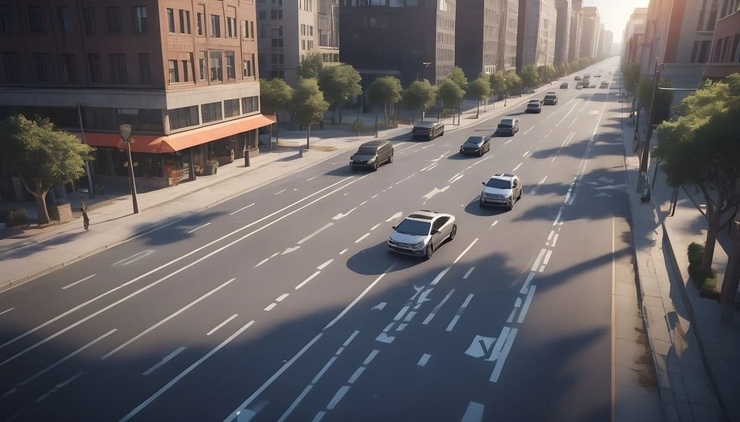- Route Optimization
What is Route Scheduling? Difference Between Routing & Scheduling.
Table of Contents

Routing and scheduling are two distinct processes that are integral to logistics management. Both are critical to ensure timely delivery of goods and services. However, many businesses fail to understand the difference between the two, leading to inefficiencies and delays. In this blog, we will specifically focus on route scheduling - what it is, why it is important, and the advantages it offers.
What is Route Scheduling?
Route scheduling refers to the process of planning and organizing transportation routes to ensure timely delivery of goods or services. It involves deciding on the most efficient order of stops based on multiple factors such as delivery time, distance, traffic conditions, and driver availability. A well-planned route schedule ensures maximum capacity utilization and increased delivery efficiency, reducing the overall cost of transportation.
Why Delivery Route Scheduling in important? A furniture delivery example
Route scheduling in the context of furniture delivery involves planning and organizing the most efficient routes for delivering furniture to customers. This process takes into account factors like delivery addresses, delivery time windows, vehicle capacities, traffic conditions, and other logistical constraints. The goal of route scheduling is to minimize delivery costs, optimize delivery times, and enhance customer satisfaction.
Here's how route scheduling typically works in furniture delivery:
Order Processing and Grouping: Orders for furniture are received, and they are grouped based on factors like delivery locations, delivery time preferences, and the items being delivered. Grouping orders helps in planning routes that are efficient and logical.
Daily Route Planning & Optimization: Route planning software or algorithms are used to determine the most optimal delivery routes. The software takes into consideration factors like traffic patterns, road closures, delivery time windows, and vehicle capacities to create efficient routes that minimize travel time and distance.
Dispatching: Once the routes are planned, the delivery vehicles are dispatched with the scheduled orders. The delivery team follows the predetermined routes and timelines.
Real-time Updates: Some delivery route scheduling systems use real-time data to adjust routes on the fly. This can be useful for accommodating unexpected road closures, traffic delays, or changes in customer availability.
Communication: Customers are usually notified of the estimated delivery time window. This helps customers plan their day and ensures that someone is available to receive the furniture.
Now, let's consider the scenario where route scheduling is absent, and the customer is not available to receive the furniture:
Suppose a customer orders a sofa and a delivery is attempted, but the customer is not available at the scheduled time. Several issues can arise:
Additional Costs: The delivery company may incur additional costs due to the failed delivery attempt. This could include fuel costs, labor costs, and vehicle maintenance expenses.
Warehouse Charges: If the delivery cannot be completed, the furniture might need to be taken back to the warehouse. This can result in storage charges, as the warehouse space is occupied by the undelivered furniture.
Re-Delivery Charges: If the customer is unavailable for the scheduled delivery, the furniture may need to be rescheduled for delivery. Some companies may charge customers for the re-delivery attempt, which can be an inconvenience and an extra cost for the customer.
Customer Dissatisfaction: Failed delivery attempts can lead to customer dissatisfaction. Customers may become frustrated if they need to reschedule their plans to be available for the next delivery attempt.
Inefficiency: Without proper route scheduling, the delivery process becomes less efficient. The delivery vehicles may spend more time on the road due to suboptimal routes, leading to higher fuel consumption and environmental impact.
Differences between Routing and Scheduling
Routing and scheduling are two distinct yet interconnected aspects of the delivery business that focus on optimizing the movement of goods from the source to the destination. While they are related, they address different stages of the delivery process and have distinct goals:
Routing
Routing primarily deals with determining the most efficient paths for delivery vehicles to travel from the starting point to the destination points. It involves deciding the sequence of stops and the specific routes that vehicles should take. The main objective of routing is to minimize travel time, distance, and fuel consumption while considering factors such as road conditions, traffic congestion, vehicle capacities, and delivery time windows.
Key aspects of routing include:
Route Optimization: Finding the optimal path for each delivery vehicle to visit all the necessary stops in the most efficient order. This often involves using routing algorithms and software.
Traffic and Road Conditions: Taking into account real-time traffic information, road closures, and other factors that might affect travel times.
Vehicle Capacities: Ensuring that the selected routes are feasible for the capacity and size of the delivery vehicles being used.
Scheduling
Scheduling focuses on determining when deliveries should take place, taking into account constraints such as customer availability, delivery time windows, and driver work hours. The main goal of scheduling is to allocate delivery orders to specific time slots in a way that balances operational efficiency with customer convenience.
Key aspects of scheduling include:
Time Window Management: Assigning delivery time windows to each customer based on their preferences and operational constraints.
Driver Availability: Ensuring that delivery routes are planned within the available work hours of the delivery drivers.
Customer Convenience: Attempting to accommodate customer preferences for delivery times, within the logistical limitations.
Order Grouping: Combining orders with similar delivery windows or locations to maximize delivery efficiency.
Advantages of a Route Scheduler:
Delivery Route scheduling offers numerous advantages in the context of delivery operations. It plays a critical role in optimizing resource utilization, reducing costs, improving customer satisfaction, and enhancing overall operational efficiency. Here's a detailed explanation of the advantages of route scheduling:
- Cost Reduction:
Fuel Efficiency: Route scheduling ensures that delivery vehicles take the shortest and most efficient paths, minimizing travel distance and fuel consumption.
Reduced Labor Costs: Efficient routes mean less time spent on the road, which translates to fewer labor hours required for deliveries.
Vehicle Maintenance: Minimizing unnecessary mileage and reducing wear and tear on vehicles results in lower maintenance costs.
- Time Savings:
Faster Deliveries: Optimized routes enable delivery vehicles to reach their destinations more quickly, reducing overall delivery time.
Real-time Adjustments: Some route scheduling systems can account for real-time traffic conditions, allowing for route adjustments that save time.
- Increased Delivery Capacity:
Optimal Vehicle Loading: Route scheduling ensures that vehicles are loaded to their maximum capacity, leading to fewer trips for the same amount of deliveries.
Effective Route Sequencing: Deliveries are planned in an order that minimizes backtracking, further optimizing capacity utilization.
- Enhanced Customer Satisfaction:
Accurate Time Windows: Route scheduling provides customers with accurate delivery time windows, improving their ability to plan and be available for deliveries.
Fewer Delays: Efficient routes and real-time adjustments reduce the chances of delays due to traffic or other unforeseen circumstances.
Reduced Failed Deliveries: By aligning delivery times with customer availability, the likelihood of missed deliveries is reduced.
- Optimized Resource Allocation:
Driver Utilization: Route scheduling ensures that drivers are assigned optimal routes that make the most of their working hours.
Reduced Overtime: Efficient routes and well-managed schedules help minimize the need for overtime work.
- Environmental Impact:
Reduced Emissions: Shorter routes and less time spent on the road lead to reduced greenhouse gas emissions and a smaller carbon footprint.
Efficient Vehicle Use: By maximizing delivery capacity and reducing unnecessary trips, fewer vehicles are needed overall, contributing to environmental conservation.
- Improved Planning and Reporting:
Data Analysis: Route scheduling systems generate data that can be analyzed to identify trends, bottlenecks, and areas for improvement.
Performance Metrics: Delivery performance metrics can be tracked, such as on-time deliveries, route efficiency, and resource utilization.
- Flexibility and Adaptability:
Real-time Updates: Some route scheduling systems can adjust routes in real-time based on changing conditions, ensuring optimal routes even in dynamic situations.
Scalability: As the business grows, route scheduling can adapt to handle increased order volume and new delivery locations.
- Operational Consistency:
Standardized Processes: Route scheduling establishes standardized processes for planning deliveries, reducing the likelihood of errors or inconsistencies.
- Competitive Advantage:
Efficient Operations: Well-managed routes set companies apart by providing reliable and timely deliveries, leading to a competitive edge in the market.
What is an example of routing and scheduling?
Let's consider an example of routing and scheduling in the context of a furniture delivery company.
Scenario: Imagine a furniture delivery company that receives orders from customers for various pieces of furniture. The company has a fleet of delivery vehicles and needs to plan the most efficient routes and schedules for delivering the furniture to different customers.
Routing: The routing aspect focuses on determining the optimal paths for the delivery vehicles to follow to reach the customers' locations. In this example, let's say the company has received the following orders:
Customer A: Sofa (123 Main St)
Customer B: Dining Table (456 Elm St)
Customer C: Bed Frame (789 Oak St)
Customer D: Wardrobe (321 Pine St)
The company needs to find the best route that minimizes travel distance while ensuring all customers are served efficiently. A possible optimized route might be:
Start at the warehouse.
Customer B (Dining Table) at 456 Elm St.
Customer D (Wardrobe) at 321 Pine St.
Customer A (Sofa) at 123 Main St.
Customer C (Bed Frame) at 789 Oak St.
Return to the warehouse.
This routing sequence minimizes backtracking and optimizes the path, reducing the overall travel distance and time.
Scheduling: The scheduling aspect involves assigning specific time windows for deliveries and determining when the delivery vehicles should start their routes. Let's assume the company has the following time window preferences from customers:
Customer A: 9:00 AM - 12:00 PM
Customer B: 10:00 AM - 2:00 PM
Customer C: 1:00 PM - 4:00 PM
Customer D: 2:00 PM - 5:00 PM
The scheduling algorithm needs to balance these time windows with the optimized route. Taking the optimized route from the routing example, the schedule might look like this:
8:30 AM: Depart from the warehouse.
9:15 AM: Arrive at Customer B (Dining Table) - 456 Elm St.
10:00 AM: Depart from Customer B.
10:45 AM: Arrive at Customer D (Wardrobe) - 321 Pine St.
11:30 AM: Depart from Customer D.
12:15 PM: Arrive at Customer A (Sofa) - 123 Main St.
1:00 PM: Depart from Customer A.
1:45 PM: Arrive at Customer C (Bed Frame) - 789 Oak St.
2:30 PM: Depart from Customer C.
3:15 PM: Return to the warehouse.
By aligning the delivery times with the customer preferences and optimizing the route, the company ensures efficient deliveries and satisfied customers.
In this example, the routing focuses on determining the order in which deliveries should be made to minimize travel distance, while the scheduling focuses on assigning time slots that accommodate customer preferences and operational efficiency.
The Benefits of Scheduling and Routing Software for Logistics
Implementing FarEye's scheduling and routing software in logistics significantly improves operational efficiency and reduces costs. This software optimizes delivery routes by considering factors like traffic conditions, delivery windows, and vehicle capacities. As a result, companies can minimize travel distances, save fuel, and reduce labor costs. Additionally, it ensures timely deliveries, enhancing customer satisfaction and reducing the likelihood of missed deliveries. Real-time updates and adjustments further optimize routes, accommodating unforeseen changes and improving overall service reliability. This leads to streamlined operations and a competitive edge in the market.
FAQs
What is a route scheduler in logistics planning?
A route scheduler in logistics planning is a tool that determines the best sequence of stops and timings for vehicles, balancing constraints like delivery windows, vehicle capacity and traffic patterns. It often uses a truck router or truck route optimization software to automate decisions that would otherwise require manual scheduling.
How does route scheduling improve delivery efficiency?
Route scheduling improves delivery efficiency by using truck route optimization software to minimise travel distance, reduce idle time and balance workloads among drivers. The result is faster delivery cycles, lower fuel costs and higher on‑time performance because routes are dynamically optimized based on real‑world conditions and business rules.
What problems can occur without proper route scheduling?
Without proper route scheduling, logistics teams can face missed delivery windows, increased fuel costs, driver burnout and inefficient routes. Operations may rely on guesswork rather than data, leading to longer transit times, unhappy customers and higher costs. A quality truck router helps avoid these common pitfalls.
Can delivery routes be adjusted after dispatch?
Yes, modern truck route optimization software supports dynamic rerouting after dispatch. When traffic congestion, cancellations or urgent orders occur, the system can update schedules and send new directions to drivers, improving responsiveness and delivery accuracy without restarting the planning process.

Komal Puri is a seasoned professional in the logistics and supply chain industry. As the AVP of Marketing and a subject matter expert at FarEye, she has been instrumental in shaping the industry narrative for the past decade. Her expertise and insights have earned her numerous awards and recognition. Komal’s writings reflect her deep understanding of the industry, offering valuable insights and thought leadership.
Let's Talk to Our Experts and Optimize Your Deliveries Today!
An expert from our team will reach out within 24 hours
Related resources


